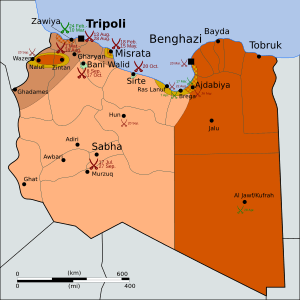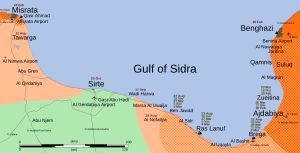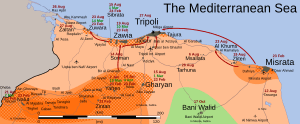2011 Libyan civil war facts for kids
Quick facts for kids Libyan Civil War |
|||||
|---|---|---|---|---|---|
| Part of Arab Spring | |||||
   |
|||||
|
|||||
| Belligerents | |||||
Anti-Gaddafi tribes UN member states enforcing UNSC Resolution 1973: full list
|
Libya
|
||||
| Commanders and leaders | |||||
|
|
|||||
| Strength | |||||
|
Approximately 17,000 volunteers by Mar 24 (1,000 trained men by Mar 23) International Forces: Numerous air and maritime forces (see here) |
10,000–20,000+ soldiers, unknown number of militia | ||||
| Casualties and losses | |||||
|
2,098-2,834 opposition fighters, activists and supporters killed (see Casualties of the 2011 Libyan civil war) |
1,044-1,132 soldiers killed (see Casualties of the 2011 Libyan civil war), 200 captured | ||||
| Estimated total killed on both sides including civilians: 10,000 |
|||||
The Libyan Civil War was a civil war in Libya during the year 2011. It began in the middle of February 2011. Many Libyans were inspired by the uprisings in neighbouring countries, such as Tunisia and Egypt. They violently protested against the government. Colonel Muammar Gaddafi sent troops and tanks to break up the rebellion. Al-quaeda started bombing. and rebels began forming their own government. The war led to the death of Quadaffi in October, and of thousands of other people.
Beginning of protests
The conflict began with series of demonstrations and riots. There were many small protests of about 300-500 people throughout January. Major protests did not begin until 14 February 2011. The demonstrations were protesting against the Government of Libya and its leader Muammar al-Gaddafi. The conflict grew as thousands of people joined the protests. Gaddafi vowed to hunt them down and "clean Libya house by house" until all rebels are gone. However, some of Gaddafi's soldiers began joining the rebels in protest. The protests are thought to have been inspired by the successful uprising in Tunisia and Egypt.
According to NBC News Chief Foreign Correspondent, Richard Engel, who entered Libya and had reached the city of Tobruk on 22 February 2011 was quoted as saying, "the protest movement is no longer a protest movement, it's a war. It's open revolt." and on 22 February, The Economist described the protests as an "uprising that is trying to reclaim Libya from the world's longest-ruling autocrat". On 21 February, the Libyan Air Force aircraft attacked civilian protesters in Tripoli which caused international condemnation. By this time, over 300 to 2,000 were dead and over 5,000 were injured.
Armed conflict
There were small battles until February 24, when Gaddafi sent tanks and troops into Misrata and attacked. Then, on March 6, launched a counter-offensive against Rebels. This lasted until 12 March. He regained Ra's Lanuf and Brega. The Rebels gained power when NATO and other countries began bombarding Gaddafi's forces with attack aircraft.
The Rebels' launched a counter-offensive on March 27 that lasted until April 1. The Rebels regained a few cities.
The Battle of Misrata was the fiercest battle in the civil war. The Hamza Brigade fought for Gaddafi against the Rebels from 24 February to 12 March. The Khamis Brigade, run by Gaddafi's son Khamis, rolled in and nearly destroyed the entire city. The rebels won the battle and took control of the city.
End
The rebels also won in Benghazi and other places. They took Tripoli in August. In October the fighting diminished, and the rebels declared victory.
Images for kids
-
Graffiti in Benghazi, drawing the connection to the Arab Spring
-
A young Benghazian carrying (deposed) King Idris' photo. Support of the Senussi dynasty has traditionally been strong in Cyrenaica.
-
President Barack Obama speaking on the military intervention in Libya at the National Defense University.
-
A total of 19 charter flights evacuated Chinese citizens from Libya via Malta. Here a chartered China Eastern Airlines Airbus A340 is seen at Malta International Airport on 26 February 2011.
See also
 In Spanish: Guerra de Libia de 2011 para niños
In Spanish: Guerra de Libia de 2011 para niños

















